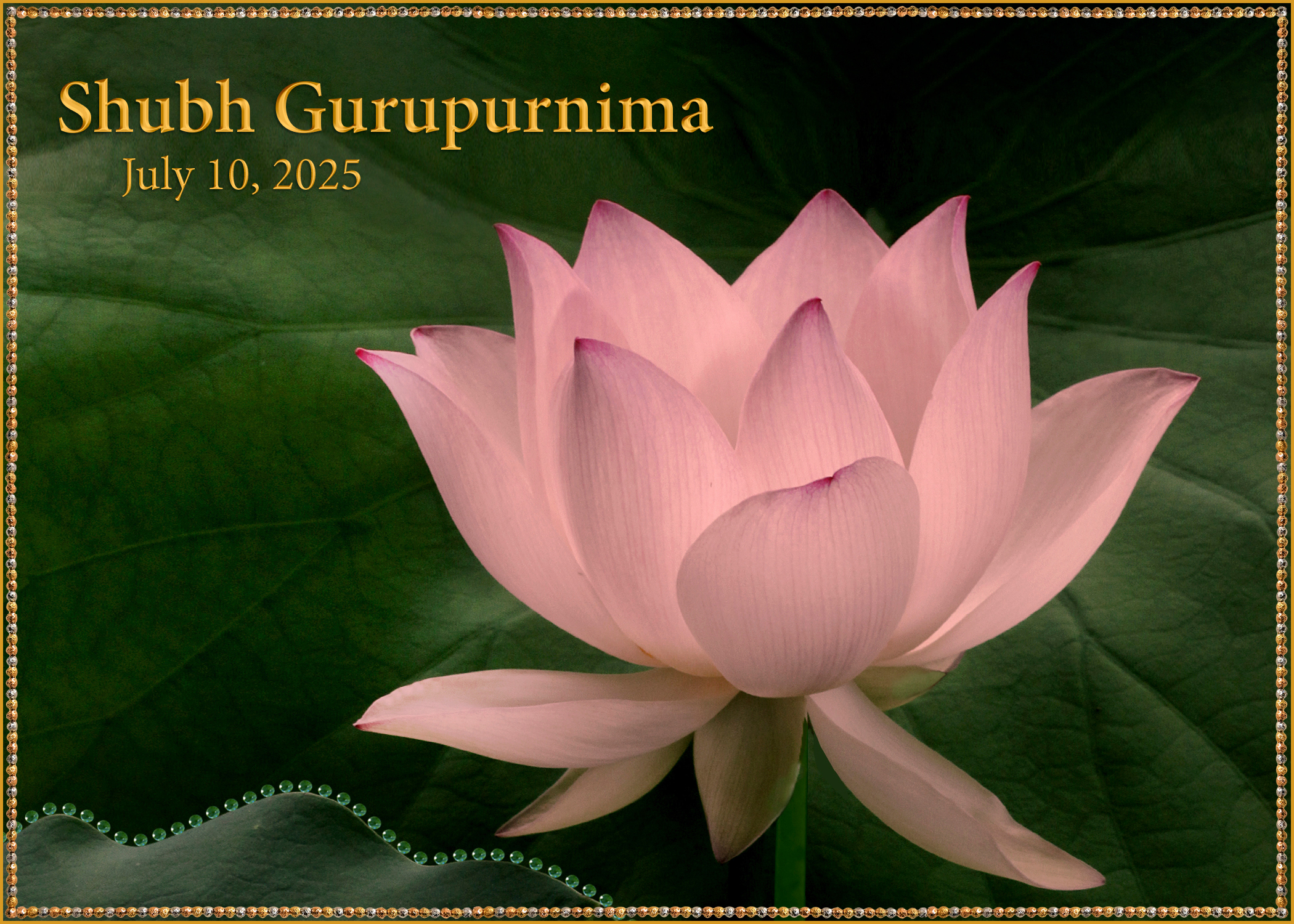





Looking at the Gurupurnima invitation card for this year, I was strongly drawn to the picture of the lotus, so I decided to study it in a more detailed way. I looked at the lines, the colors, where the light came from, and how the light illumined the beautiful flower. As I contemplated every aspect of the artwork, I felt a sense of familiarity and ease arising inside me.
Now, every time I look at the card, I find that my heart is at peace. I feel that giving to my Guru is as natural as the beautiful blooming of the delicate pink flower in this picture. It is a sweet and loving remembrance of the Guru-disciple connection.
Rome, Italy
As a young girl visiting our local temple with my parents, I loved offering dakshina and hearing the sound of my coins dropping into the collection box below. But only after I met my Guru and began walking the Siddha Yoga path did my experience of offering dakshina become truly heartfelt.
Year after year during Gurupurnima month, my love for my Guru vibrates in each cell of my being, and it is heightened on the day of Gurupurnima when I send in my dakshina. This is exactly how I feel right now. My eyes are moist, my heart has melted, and love is spreading within me with gratitude and complete surrender.
Nairobi, Kenya
Offering dakshina has become an important practice for me—a way of expressing gratitude for all that I have received on the Siddha Yoga path: the immense gift of shaktipat, the many experiences of the inner shakti unfolding, the Siddha Yoga teachings, and the guidance to see the hand of God in every situation.
When I offer dakshina, I feel deeply connected to Gurumayi’s love, my faith in God, and my unique relationship with Gurumayi.
Marlanval, France
I have always loved celebrating Gurupurnima and feel especially close to Gurumayi during this month.
As I sat in meditation before offering dakshina on this Gurupurnima, I felt indebted to my Guru. I felt a stirring in my heart and said to her, “I love you, I love you, I love you.” Instantly, I felt the love of my beloved Guru rising within me. I felt immense gratitude to experience this circle of love.
Eastbourne, United Kingdom
Delicate frame of rainbow-colored pearls,
each pearl a Siddha Yogi,
each one practicing the Guru’s gifts.
Pearls bathed in the treasures revealed:
transient outer beauty,
eternal inner stillness.
Both aspects of the Self,
rising and subsiding,
meeting between each breath,
offering sustenance and strength.
I step into each moment,
wide-eyed and awakened,
like the lotus in full bloom.
New York, United States
Today, on this blessed day of Gurupurnima, I left work early to come home to recite Shri Guru Gita. First, I recited the “Five Stanzas on the Sandals of Shri Guru,” followed by the text of Shri Guru Gita, and then I performed arati. Afterward, I sat in front of my puja with my laptop to offer dakshina on the Siddha Yoga path website.
Though I didn’t hear any words, I imagine my heart must have asked the question, “Why do you offer dakshina?” because these words arose from me to Gurumayi:
I love to say, “I love you.”
I love to worship you.
I love to ask to always be beholden to you.
I love to offer of myself to you.
Guildford, United Kingdom
After offering dakshina on Gurupurnima, I sat to meditate. In meditation, I saw golden particles emanating from my being and flying through the sky. They flew until they reached other golden particles that were dancing and swirling in a beautiful funnel. In the center of this divine energy, I saw Gurumayi seated, meditating. It seemed as if the energy of all the Siddha Yogis from around the world had gathered on the day of Gurupurnima to celebrate the Guru.
Sinard, France
For many years I have offered dakshina on Gurupurnima as a way of honoring Gurumayi and in gratitude for all the ways that the Guru’s grace protects, sustains, and empowers me in this life, and beyond. As with my monthly dakshina practice, my Gurupurnima offering is a tangible way of remembering and honoring the Self, which enlivens all creation, including my own heart.
North Carolina, United States
This morning in meditation, I had a tangible experience of the truth of Swami ji’s words: “I deeply sense that the energy of God which vibrates unequivocally in the universe is the same energy that has been awakened within me by my Guru.” This occurred after I realized that what I wanted from another was in fact already within me. With this awareness came a rush of beautiful, tender ecstasy, and I enjoyed being with myself.
I am thankful for receiving shaktipat and for the grace of the Siddha Gurus.
Warrnambool, Australia
Swami Indirananda’s letter is a sweet reminder of what truly matters to me. Every time I offer dakshina, I feel a deep sense of joy and contentment rising within as I express my love and gratitude to my Guru. When I am gazing at the magnificent beauty of the full moon of Gurupurnima, I am deeply connected to my innermost truth: my Guru is the root, the heart, the path, and the destination of my life.
I am blessed and honored to offer dakshina on this very special day of Gurupurnima, in heartfelt homage to my beloved Siddha Gurus.
Quebec, Canada
Each year the unfolding petals of the lotus flower greet me on the Siddha Yoga Path website—heralding Gurupurnima. Today, I took time to be with this image, drinking in the light, shapes, and colors. Even in a still image, the quality of aliveness and vibrancy was captivating.
I have lived through many moons—and many Gurupurnimas! Curious about how the lotus has been represented in prior years, and using the yearly index on the Siddha Yoga Path website, I found this aliveness in each unique, resplendent expression of the lotus. Each one evokes the fullness and generosity of the Guru’s love.
Taking time to review and contemplate the lotus imagery invited my own heart to bloom with gratitude, leading me naturally to the practice of dakshina, offering my fullness back to the great Heart, from which all arises and all returns. Thus, the Guru-disciple relationship plays out again and again, year after year—within time, yet evoking the timeless.
Massachusetts, United States
Recently I wondered, “How can I cultivate a deeper connection with Gurumayi, and how can I feel her presence and wisdom in my own being?”
That same night, I had a vivid dream in which Gurumayi was giving a talk in Guru Chowk in Gurudev Siddha Peeth; then we were asked to go to the library, where we sat in a concentric circle. Gurumayi came and sat with us—she was looking at me. There was no conversation in the dream, but I realized that she gave me her darshan through this dream just before Gurupurnima.
After waking up, I wrote in my journal that she was there to assure me of our intrinsic connection, and that there is no separation between us.
Vapi, India
The month of Gurupurnima is such an inspiring time on the Siddha Yoga path website—from the image of the lotus in this invitation to the stories and more. For me, each day is colored by sweet gratitude and love. While I acknowledge that walking this path is essential to me at all times, this particular month seems to have a unique and deep influence on how I see my world.
Being able to give back to that which I hold dear connects me to Gurumayi. Offering dakshina during Gurupurnima opens my heart, brings me a sense of contentment and purpose, and is a way I can express that Gurumayi is at the center of my world.
Hampton Hill, United Kingdom
Yesterday, I gazed at this beautiful image and read the invitation from Swami Indirananda. In the evening, I took a walk by the river under the light of the waxing moon. I felt especially connected to the moon. When I woke up this morning, my first thoughts were of the Guru’s grace and blessings, which have enriched my life over nearly four decades of my following the Siddha Yoga path. I became aware that my very being is suffused with the light and presence of the Guru. Just as I felt the light of the moon guiding me through my walk in the dark last night, I experience the inner light of the Guru with me, beneficently guiding my every step.
The lovely beads around the border and near the bottom of the card remind me of Gurumayi’s Message Artwork; they remind me of all the beautiful moments in time that make up my life. They remind me to offer my best to each moment. I am greatly looking forward to offering dakshina on the auspicious day of Gurupurnima.
California, United States
I love the practice of dakshina. Through this divine practice, my life has been totally transformed into a temple of grace. Dakshina has drawn me into the wondrous cycle of giving and receiving through which I experience that my Guru is always with me—teaching me, guiding me, protecting me, and filling me with divine love.
Florida, United States
I have received immeasurable grace and blessings from my beloved Gurumayi. Though there is no way to ever repay the Guru’s glorious gifts—her presence on earth, the bestowal of shaktipat-diksha and continual showering of grace, her teachings, guidance, and wisdom—I can attempt to express my gratitude by offering seva and dakshina. These offerings keep my heart open to connect to Gurumayi’s grace and presence within.
California, United States




















